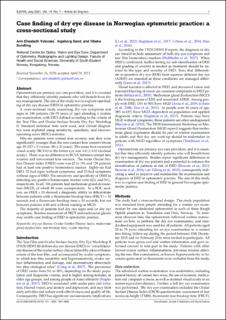Case finding of dry eye disease in Norwegian optometric practice: a cross-sectional study
Peer reviewed, Journal article
Published version

View/
Date
2021Metadata
Show full item recordCollections
Original version
Ystenæs, A. E., Sand, I., & Sundling, V. (2021). Case finding of dry eye disease in Norwegian optometric practice: a cross-sectional study . Scandinavian Journal of Optometry and Visual Science, 14(1), 1–6. https://doi.org/10.5384/sjovs.v14i1.131Abstract
Optometrists are primary eye care providers, and it is essentialthat they efficiently identify patients who will benefit from dryeye management. The aim of the study was to explore case find-ing of dry eye disease (DED) in optometric practice.A cross-sectional study examining dry eye symptoms andsigns in 186 patients (18–70 years of age) attending a routineeye examination, with DED defined according to the criteria ofthe Tear Film and Ocular Surface Society Dry Eye WorkshopII. Standard statistical tests were used, and clinical diagnos-tics were explored using sensitivity, specificity, and receiver-operating curve (ROC) statistics.Fifty-six patients were contact lens wearers, and they weresignificantly younger than the non-contact lens wearers (meanage 35 (SD= 1) versus 48 (± 2) years). The mean best correctedvisual acuity (BCVA) in the better eye was 1.0 (± 0.1) (decimalacuity). There was no difference in BCVA between contact lenswearers and non-contact lens wearers. The mean Ocular Sur-face Disease Index (OSDI) score was 22 (± 19), and 138 patientshad at least one positive homeostasis marker. Eighty-six hadDED, 52 had signs without symptoms, and 23 had symptomswithout signs of DED. The sensitivity and specificity of OSDI indetecting any positive homeostasis marker were 62% and 54%,respectively. In all, 106 patients had meibomian gland dysfunc-tion (MGD), of which 49 were asymptomatic. In a ROC anal-ysis, an OSDI ≥ 13 showed a diagnostic ability to differentiatebetween patients with a fluorescein breakup time (FBUT) < 10seconds and a fluorescein breakup time ≥ 10 seconds, but notbetween patients with and without staining or MGD.The majority of patients had dry eye signs and/or dry eyesymptoms. Routine assessmentofFBUT and meibomian glandsmay enable case finding of DED in optometric practice.
